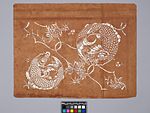katagami (Stencil)
About this object
History of use
The katazome method of dying fabric used a resist paste applied through a stencil; when the paste dried the stencil was removed and colour was applied by brush. The paste was then washed away leaving undyed areas to form pattern against coloured ground. Prior to the 16th century cut stencils were used to colour leather armour. However, during the Edo Period (1603-1868) the technique was developed as a true native craft.
Cultural context
fabric printing
Iconographic meaning
Carp: perseverance; bamboo: strength, long life, good luck , endurance
Physical description
The rectangular stencil has two circular shaped carps with interlocking oval bamboo medallions diagonally set with three clumps of blossoms in between and scattered circular designs. There are three register points along the long sides and four along the short sides. A white sheet is attached to the back of the stencil.
Categories
Materials
Cut Laminated Smoked Dried / paper Persimmon juice
